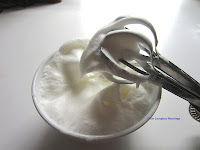Surprise! It’s
Christmas, I’m not busy, and in our house it’s all about the food, so
naturally I thought of you. This will be brief, but loaded with butter and
wine.
Christmas Eve is when we have our big dinner; even for the seasonally
small family of me and my son out here in Tucson, it is big, probably too much
so. But as Bob Cratchit said, it’s only once a year.

So what did we have? A
number of years ago my son and I shifted away from our usual very English Prime
Rib roast, Yorkshire pudding, creamed onions, pies,
plum
pudding, etc., etc. (very good, mind) to doing something different every
year. Last year was one of our all-time great dinners, themed around my first
year in the Southwest (and thank you, Bobby Flay, for inspiration). A
simple
dinner in my son’s tiny New York apartment in 2010 was another. Generally, the meal does still center around
beef, though. But this year I got a text from my son a few weeks ago asking, “Can
we have rack of lamb for Christmas?” Sure,
why not? So after talking options for
approach—Southwest again, Middle Eastern, French—we settled on the classic:
French.
Here’s the four-course menu—served with French wines (a
white burgundy and a good Haut-Medoc), with a Warre 1994 vintage port with our
dessert—and a recipe for the soup, a favorite of mine. Jordan really liked the
ice cream:
Chestnut Soup with
Herbed Puff Pastry Twists
 Salad of red leaf, radicchio,
fennel, and leek with maple-pomegranate vinaigrette
Salad of red leaf, radicchio,
fennel, and leek with maple-pomegranate vinaigrette
Rack of Lamb
Persillade with Fig Sauce
Duchesse Potatoes
Glazed Onions
Haricots vertes with hazelnut butter and thyme
Coconut-ginger ice
cream with truffles and cookies
Happy Holidays, and happy eating, to all.
 Chestnut Soup
Chestnut Soup
This is a delicious and somewhat luxurious soup, suited to
the season. You can make it ahead; add
the cream when you reheat if you do. Serves
6-8 (6 rim soup, or 1-cup, portions).
3
tablespoons unsalted butter
1/2
cup each finely chopped celery, carrot, and onion
A
few sprigs flat-leaf parsley
3-4
whole cloves
1 large dried bay leaf--make sure it is new
6
cups chicken stock, on the light side
3
cups cooked
whole chestnuts, peeled and crumbled;
you can do them fresh, or buy jarred or vacuum-
packed
1/4
cup tawny
port or Madeira
1/4
cup heavy cream
1/4
teaspoon black pepper and a little salt
Fennel
tops or chopped parsley for garnish
Make a bouquet
garni: Tie the parsley, cloves, and bay leaf up in a piece of cheesecloth.
Melt the butter
in a 3-quart heavy saucepan over low heat, add the chopped celery, carrot, and
onion, and cover the vegetables with a buttered round of wax paper, buttered
side down. Cover the pan and sweat the vegetables until soft, about 15 minutes.
Discard the wax
paper. Add the stock and bouquet garni to the pan. Bring to a boil, then reduce the heat and
simmer, covered, 20 minutes. Add chestnuts (you can crumble them in with your
hands at this point) and the port or Madeira. Simmer, covered, for about 3
minutes.

In a large food
processor or blender, purée in 3 or 4 batches until smooth, transferring each batch to a
bowl. Place a strainer over a clean 3- to 4-quart saucepan and strain the puréed
soup into the pan. Reheat, and add the cream, salt, and pepper, stirring
occasionally. Taste for seasoning.
Garnish with the
small feathery fronds of fennel or some chopped parsley. You could also float a
little round of puff paste or a star-shaped crouton, or a disc of parsley
butter.
 So what did we have? A
number of years ago my son and I shifted away from our usual very English Prime
Rib roast, Yorkshire pudding, creamed onions, pies, plum
pudding, etc., etc. (very good, mind) to doing something different every
year. Last year was one of our all-time great dinners, themed around my first
year in the Southwest (and thank you, Bobby Flay, for inspiration). A simple
dinner in my son’s tiny New York apartment in 2010 was another. Generally, the meal does still center around
beef, though. But this year I got a text from my son a few weeks ago asking, “Can
we have rack of lamb for Christmas?” Sure,
why not? So after talking options for
approach—Southwest again, Middle Eastern, French—we settled on the classic:
French.
So what did we have? A
number of years ago my son and I shifted away from our usual very English Prime
Rib roast, Yorkshire pudding, creamed onions, pies, plum
pudding, etc., etc. (very good, mind) to doing something different every
year. Last year was one of our all-time great dinners, themed around my first
year in the Southwest (and thank you, Bobby Flay, for inspiration). A simple
dinner in my son’s tiny New York apartment in 2010 was another. Generally, the meal does still center around
beef, though. But this year I got a text from my son a few weeks ago asking, “Can
we have rack of lamb for Christmas?” Sure,
why not? So after talking options for
approach—Southwest again, Middle Eastern, French—we settled on the classic:
French. In a large food
processor or blender, purée in 3 or 4 batches until smooth, transferring each batch to a
bowl. Place a strainer over a clean 3- to 4-quart saucepan and strain the puréed
soup into the pan. Reheat, and add the cream, salt, and pepper, stirring
occasionally. Taste for seasoning.
In a large food
processor or blender, purée in 3 or 4 batches until smooth, transferring each batch to a
bowl. Place a strainer over a clean 3- to 4-quart saucepan and strain the puréed
soup into the pan. Reheat, and add the cream, salt, and pepper, stirring
occasionally. Taste for seasoning.













































.JPG)

